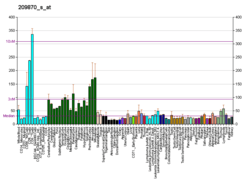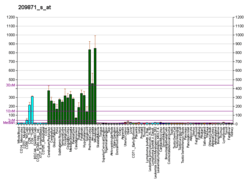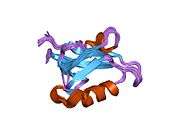APBA2
Amyloid beta A4 precursor protein-binding family A member 2 is a protein that in humans is encoded by the APBA2 gene.[5][6]
Function
The protein encoded by this gene is a member of the X11 protein family. It is a neuronal adaptor protein that interacts with the Alzheimer's disease amyloid precursor protein (APP). It stabilises APP and inhibits production of proteolytic APP fragments including the A beta peptide that is deposited in the brains of Alzheimer's disease patients. This gene product is believed to be involved in signal transduction processes. It is also regarded as a putative vesicular trafficking protein in the brain that can form a complex with the potential to couple synaptic vesicle exocytosis to neuronal cell adhesion.[6]
Interactions
APBA2 has been shown to interact with CLSTN1,[7][8] RELA[9] and Amyloid precursor protein.[7][10][11]
References
- ENSG00000276495 GRCh38: Ensembl release 89: ENSG00000034053, ENSG00000276495 - Ensembl, May 2017
- GRCm38: Ensembl release 89: ENSMUSG00000030519 - Ensembl, May 2017
- "Human PubMed Reference:". National Center for Biotechnology Information, U.S. National Library of Medicine.
- "Mouse PubMed Reference:". National Center for Biotechnology Information, U.S. National Library of Medicine.
- McLoughlin DM, Miller CC (January 1997). "The intracellular cytoplasmic domain of the Alzheimer's disease amyloid precursor protein interacts with phosphotyrosine-binding domain proteins in the yeast two-hybrid system". FEBS Lett. 397 (2–3): 197–200. doi:10.1016/S0014-5793(96)01128-3. PMID 8955346.
- "Entrez Gene: APBA2 amyloid beta (A4) precursor protein-binding, family A, member 2 (X11-like)".
- Araki Y, Tomita S, Yamaguchi H, Miyagi N, Sumioka A, Kirino Y, Suzuki T (December 2003). "Novel cadherin-related membrane proteins, Alcadeins, enhance the X11-like protein-mediated stabilization of amyloid beta-protein precursor metabolism". J. Biol. Chem. 278 (49): 49448–58. doi:10.1074/jbc.M306024200. PMID 12972431.
- Araki Y, Miyagi N, Kato N, Yoshida T, Wada S, Nishimura M, Komano H, Yamamoto T, De Strooper B, Yamamoto K, Suzuki T (June 2004). "Coordinated metabolism of Alcadein and amyloid beta-protein precursor regulates FE65-dependent gene transactivation". J. Biol. Chem. 279 (23): 24343–54. doi:10.1074/jbc.M401925200. PMID 15037614.
- Tomita S, Fujita T, Kirino Y, Suzuki T (April 2000). "PDZ domain-dependent suppression of NF-kappaB/p65-induced Abeta42 production by a neuron-specific X11-like protein". J. Biol. Chem. 275 (17): 13056–60. doi:10.1074/jbc.C000019200. PMID 10777610.
- Biederer T, Cao X, Südhof TC, Liu X (September 2002). "Regulation of APP-dependent transcription complexes by Mint/X11s: differential functions of Mint isoforms". J. Neurosci. 22 (17): 7340–51. doi:10.1523/JNEUROSCI.22-17-07340.2002. PMID 12196555.
- Tomita S, Ozaki T, Taru H, Oguchi S, Takeda S, Yagi Y, Sakiyama S, Kirino Y, Suzuki T (January 1999). "Interaction of a neuron-specific protein containing PDZ domains with Alzheimer's amyloid precursor protein". J. Biol. Chem. 274 (4): 2243–54. doi:10.1074/jbc.274.4.2243. PMID 9890987.
External links
- Human APBA2 genome location and APBA2 gene details page in the UCSC Genome Browser.
Further reading
- van der Geer P, Pawson T (1995). "The PTB domain: a new protein module implicated in signal transduction". Trends Biochem. Sci. 20 (7): 277–80. doi:10.1016/S0968-0004(00)89043-X. PMID 7545337.
- Andersson B, Wentland MA, Ricafrente JY, Liu W, Gibbs RA (1996). "A "double adaptor" method for improved shotgun library construction". Anal. Biochem. 236 (1): 107–13. doi:10.1006/abio.1996.0138. PMID 8619474.
- Yu W, Andersson B, Worley KC, Muzny DM, Ding Y, Liu W, Ricafrente JY, Wentland MA, Lennon G, Gibbs RA (1997). "Large-scale concatenation cDNA sequencing". Genome Res. 7 (4): 353–8. doi:10.1101/gr.7.4.353. PMC 139146. PMID 9110174.
- Okamoto M, Südhof TC (1998). "Mints, Munc18-interacting proteins in synaptic vesicle exocytosis". J. Biol. Chem. 272 (50): 31459–64. doi:10.1074/jbc.272.50.31459. PMID 9395480.
- Blanco G, Irving NG, Brown SD, Miller CC, McLoughlin DM (1998). "Mapping of the human and murine X11-like genes (APBA2 and apba2), the murine Fe65 gene (Apbb1), and the human Fe65-like gene (APBB2): genes encoding phosphotyrosine-binding domain proteins that interact with the Alzheimer's disease amyloid precursor protein". Mamm. Genome. 9 (6): 473–5. doi:10.1007/s003359900800. PMID 9585438.
- Borg JP, Yang Y, De Taddéo-Borg M, Margolis B, Turner RS (1998). "The X11alpha protein slows cellular amyloid precursor protein processing and reduces Abeta40 and Abeta42 secretion". J. Biol. Chem. 273 (24): 14761–6. doi:10.1074/jbc.273.24.14761. PMID 9614075.
- Borg JP, Straight SW, Kaech SM, de Taddéo-Borg M, Kroon DE, Karnak D, Turner RS, Kim SK, Margolis B (1998). "Identification of an evolutionarily conserved heterotrimeric protein complex involved in protein targeting". J. Biol. Chem. 273 (48): 31633–6. doi:10.1074/jbc.273.48.31633. PMID 9822620.
- Okamoto M, Südhof TC (1999). "Mint 3: a ubiquitous mint isoform that does not bind to munc18-1 or -2". Eur. J. Cell Biol. 77 (3): 161–5. doi:10.1016/s0171-9335(98)80103-9. PMID 9860131.
- Tomita S, Ozaki T, Taru H, Oguchi S, Takeda S, Yagi Y, Sakiyama S, Kirino Y, Suzuki T (1999). "Interaction of a neuron-specific protein containing PDZ domains with Alzheimer's amyloid precursor protein". J. Biol. Chem. 274 (4): 2243–54. doi:10.1074/jbc.274.4.2243. PMID 9890987.
- McLoughlin DM, Irving NG, Brownlees J, Brion JP, Leroy K, Miller CC (1999). "Mint2/X11-like colocalizes with the Alzheimer's disease amyloid precursor protein and is associated with neuritic plaques in Alzheimer's disease". Eur. J. Neurosci. 11 (6): 1988–94. doi:10.1046/j.1460-9568.1999.00610.x. PMID 10336668.
- Tomita S, Fujita T, Kirino Y, Suzuki T (2000). "PDZ domain-dependent suppression of NF-kappaB/p65-induced Abeta42 production by a neuron-specific X11-like protein". J. Biol. Chem. 275 (17): 13056–60. doi:10.1074/jbc.C000019200. PMID 10777610.
- Gotthardt M, Trommsdorff M, Nevitt MF, Shelton J, Richardson JA, Stockinger W, Nimpf J, Herz J (2000). "Interactions of the low density lipoprotein receptor gene family with cytosolic adaptor and scaffold proteins suggest diverse biological functions in cellular communication and signal transduction". J. Biol. Chem. 275 (33): 25616–24. doi:10.1074/jbc.M000955200. PMID 10827173.
- Lee DS, Tomita S, Kirino Y, Suzuki T (2000). "Regulation of X11L-dependent amyloid precursor protein metabolism by XB51, a novel X11L-binding protein". J. Biol. Chem. 275 (30): 23134–8. doi:10.1074/jbc.C000302200. PMID 10833507.
- Biederer T, Südhof TC (2001). "Mints as adaptors. Direct binding to neurexins and recruitment of munc18". J. Biol. Chem. 275 (51): 39803–6. doi:10.1074/jbc.C000656200. PMID 11036064.
- Lau KF, McLoughlin DM, Standen C, Miller CC (2001). "X11 alpha and x11 beta interact with presenilin-1 via their PDZ domains". Mol. Cell. Neurosci. 16 (5): 557–65. doi:10.1006/mcne.2000.0898. PMID 11083918.
- Sutcliffe JS, Han MK, Amin T, Kesterson RA, Nurmi EL (2003). "Partial duplication of the APBA2 gene in chromosome 15q13 corresponds to duplicon structures". BMC Genomics. 4 (1): 15. doi:10.1186/1471-2164-4-15. PMC 156605. PMID 12720574.
- Sumioka A, Imoto S, Martins RN, Kirino Y, Suzuki T (2003). "XB51 isoforms mediate Alzheimer's beta-amyloid peptide production by X11L (X11-like protein)-dependent and -independent mechanisms". Biochem. J. 374 (Pt 1): 261–8. doi:10.1042/BJ20030489. PMC 1223589. PMID 12780348.








